
- Afhalen na 1 uur in een winkel met voorraad
- Gratis thuislevering in België vanaf € 30
- Ruim aanbod met 7 miljoen producten
- Afhalen na 1 uur in een winkel met voorraad
- Gratis thuislevering in België vanaf € 30
- Ruim aanbod met 7 miljoen producten
Zoeken
Specialized Dementia
A Type of Alzheimer's Disease
Dhairya Y Joshi, Nirav D Parmar, Bhuvan P Raval
Paperback | Engels
€ 48,45
+ 96 punten
Omschrijving
It was first described by Alois Alzheimer in 1906. At a scientific meeting in November 1906, German physician Alois Alzheimer presented the case of "Frau Auguste D.," a 51-year-old woman brought to see him in 1901 by her family. Auguste had developed problems with memory, unfounded suspicions that her husband was unfaithful, and difficulty speaking and understanding what was said to her. Her symptoms rapidly grew worse, and within a few years she was bedridden. She died in spring 1906.Dr. Alzheimer had never before seen anyone like Auguste D., and he gained the family's permission to perform an autopsy. In Auguste's brain, he saw dramatic shrinkage, especially of the cortex, the outer layer involved in memory, thinking, judgment and speech. Under the microscope, he also saw widespread fatty deposits in small blood vessels, dead and dying brain cells, and abnormal deposits in and around cells. The condition entered the medical literature in 1907, when Alzheimer published his observations about Auguste D. In 1910, Emil Kraepelin, a psychiatrist noted for his work in naming and classifying brain disorders, proposed that the disease be named after Alzheimer.
Specificaties
Betrokkenen
- Auteur(s):
- Uitgeverij:
Inhoud
- Aantal bladzijden:
- 64
- Taal:
- Engels
Eigenschappen
- Productcode (EAN):
- 9783848449057
- Verschijningsdatum:
- 24/03/2012
- Uitvoering:
- Paperback
- Formaat:
- Trade paperback (VS)
- Afmetingen:
- 152 mm x 229 mm
- Gewicht:
- 104 g

Alleen bij Standaard Boekhandel
+ 96 punten op je klantenkaart van Standaard Boekhandel
Beoordelingen
We publiceren alleen reviews die voldoen aan de voorwaarden voor reviews. Bekijk onze voorwaarden voor reviews.











